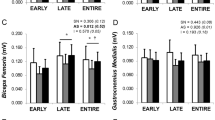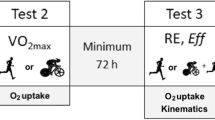Abstract
We investigated the changes in constant velocity spring-mass behavior after high intensity sprint fatigue in order to better interpret the results recently reported after ultra-long distance (ULD) exercises. Our hypothesis was that after repeated sprints (RS), subjects may likely experience losses of force such as after ULD, but the necessity to modify their running pattern to attenuate the overall impact at each step (such as after ULD) may not be present. Eleven male subjects performed four sets of five 6-s sprints with 24-s recovery between sprints and 3 min between sets, on a sprint treadmill and on a bicycle ergometer. For each session, their running mechanics and spring-mass characteristics were measured at 10 and 20 km h−1 on an instrumented treadmill before and after RS. Two-way (period and velocity) ANOVAs showed that high-intensity fatigue did not induce any change in the constant velocity running pattern at low or high velocity, after both running and cycling RS, despite significant decreases (P < 0.001) in maximal power (−27.1 ± 8.2% after running RS and −15.4 ± 11.5 % after cycling RS) and knee extensors maximal voluntary force (−18.8 ± 6.7 % after running RS and −15.0 ± 7.6 % after cycling RS). These results bring indirect support to the hypothesis put forward in recent ULD studies that the changes in running mechanics observed after ULD are likely not related to the decrease in strength capabilities, but rather to the necessity for subjects to adopt a protective running pattern.
Similar content being viewed by others
References
Avogadro P, Dolenec A, Belli A (2003) Changes in mechanical work during severe exhausting running. Eur J Appl Physiol 90:165–170
Beckett JR, Schneiker KT, Wallman KE, Dawson BT, Guelfi KJ (2009) Effects of static stretching on repeated sprint and change of direction performance. Med Sci Sports Exerc 41:444–450
Bigland-Ritchie B, Woods JJ (1984) Changes in muscle contractile properties and neural control during human musculature fatigue. Muscle Nerve 7:691–699
Billaut F, Bishop DJ, Schaerz S, Noakes TD (2011) Influence of knowledge of sprint number on pacing during repeated-sprint exercise. Med Sci Sports Exerc 43:665–672
Blickhan R (1989) The spring-mass model for running and hopping. J Biomech 22:1217–1227
Borrani F, Candau R, Perrey S, Millet GY, Millet GP, Rouillon JD (2003) Does the mechanical work in running change during the VO2 slow component? Med Sci Sports Exerc 35:50–57
Braun WA, Dutto DJ (2003) The effects of a single bout of downhill running and ensuing delayed onset muscle soreness on running economy performed 48 h later. Eur J Appl Physiol 90:29–34
Candau R, Belli A, Millet GY, Georges D, Barbier B, Rouillon JD (1998) Energy cost and running mechanics during a treadmill run to voluntary exhaustion in humans. Eur J Appl Physiol Occup Physiol 77:479–485
Cavagna GA (1975) Force platforms as ergometers. J Appl Physiol 39:174–179
Cavagna GA, Legramandi MA, Peyré-Tartaruga LA (2007) Old men running: mechanical work and elastic bounce. Proc R Soc B 275:411–418
Chelly SM, Denis C (2001) Leg power and hopping stiffness: relationship with sprint running performance. Med Sci Sports Exerc 33:326–333
Chen TC, Nosaka K, Tu JH (2007) Changes in running economy following downhill running. J Sport Sci 25:55–63
Dutto DJ, Smith GA (2002) Changes in spring-mass characteristics during treadmill running to exhaustion. Med Sci Sports Exerc 34:1324–1331
Enoka RM, Stuart DG (1992) Neurobiology of muscle fatigue. J Appl Physiol 72:1631–1648
Farley CT, Gonzalez O (1996) Leg stiffness and stride frequency in human running. J Biomech 29:181–186
Farley CT, Ferris DP (1998) Biomechanics of walking and running: center of mass movements to muscle action. Exerc Sport Sci Rev 26:253–286
Farley CT, Glasheen J, McMahon TA (1993) Running springs: speed and animal size. J Exp Biol 185:71–86
Ferris DP, Louie M, Farley CT (1998) Running in the real world: adjusting leg stiffness for different surfaces. Proc R Soc B 265:989–994
Finni T, Kyrolainen H, Avela J, Komi PV (2003) Maximal but not submaximal performance is reduced by constant-speed 10-km run. J Sports Med Phys Fitness 43:411–417
Gaitanos GC, Nevill ME, Brooks S, Williams C (1991) Repeated bouts of sprint running after induced alkalosis. J Sports Sci 9:355–370
Gerlach KE, White SC HWB, Dorn JM, Leddy JJ, Horvath PJ (2005) Kinetic changes with fatigue and relationship to injury in female runners. Med Sci Sports Exerc 37:657–663
Girard O, Micallef JP, Millet GP (2011) Changes in spring-mass model characteristics during repeated running sprints. Eur J Appl Physiol 111:125–134
Glaister M, Howatson G, Pattison JR, McInnes G (2008) The reliability and validity of fatigue measures during multiple-sprint work: an issue revisited. J Strength Cond Res 22:1597–1601
Glaister M, Lockey RA, Abraham CS, Staerck A, Goodwin JE, McInnes G (2006) Creatine supplementation and multiple sprint running performance. J Strength Cond Res 20:273–277
Glaister M, Stone MH, Stewart AM, Hughes M, Moir GL (2005) The influence of recovery duration on multiple sprint cycling performance. J Strength Cond Res 19:831–837
Hausswirth C, Bigard XA, Guezennec CY (1997) Relationships between running mechanics and energy cost of running at the end of a triathlon and a marathon. Int J Sports Med 18:330–339
He JP, Kram R, McMahon TA (1991) Mechanics of running under simulated low gravity. J Appl Physiol 71:863–870
Hobara H, Inoue K, Gomi K, Sakamoto M, Muraoka T, Iso S, Kanosue K (2010) Continuous change in spring-mass characteristics during a 400 m sprint. J Sci Med Sport 13:256–261
Hughes MG, Doherty M, Tong RJ, Reilly T, Cable NT (2006) Reliability of repeated sprint exercise in non-motorised treadmill ergometry. Int J Sports Med 27:900–904
Hunter I, Smith GA (2007) Preferred and optimal stride frequency, stiffness and economy: changes with fatigue during a 1-h high intensity run. Eur J Appl Physiol 100:653–661
Karamanidis K, Arampatzis A (2005) Mechanical and morphological properties of different muscle–tendon units in the lower extremity and running mechanics: effect of aging and physical activity. J Exp Biol 208:3907–3923
Kyrolainen H, Pullinen T, Candau R, Avela J, Huttunen P, Komi PV (2000) Effects of marathon running on running economy and kinematics. Eur J Appl Physiol 82:297–304
Martin V, Kerhervé H, Messonnier L, Banfi J-C, Geyssant A, Bonnefoy R, Féasson L, Millet GY (2010) Central and peripheral contributions to neuromuscular fatigue induced by a 24-hour treadmill run. J Appl Physiol 108:1224–1233
McMahon TA, Cheng GC (1990) The mechanics of running: how does stiffness couple with speed? J Biomech 23(Suppl 1):65–78
Mendez-Villanueva A, Hamer P, Bishop D (2007) Fatigue responses during repeated sprints matched for initial mechanical output. Med Sci Sports Exerc 39:2219–2225
Mendez-Villanueva A, Hamer P, Bishop D (2008) Fatigue in repeated-sprint exercise is related to muscle power factors and reduced neuromuscular activity. Eur J Appl Physiol 103:411–419
Millet GY, Morin JB, Degache F, Edouard P, Féasson L, Verney J, Oullion R (2009) Running from Paris to Beijing: biomechanical and physiological consequences. Eur J Appl Physiol 107:731–738
Millet GY, Tomazin K, Verges S, Vincent L, Bonnefoy R, Boisson RC, Gergelé L, Féasson L, Martin V (2011) Neuromuscular consequences of an extreme mountain ultra-marathon. PLoS One 6:e17059
Mizrahi J, Verbitsky O, Isakov E (2001) Fatigue-induced changes in decline running. Clin Biomech (Bristol, Avon) 16:207–212
Mizrahi J, Verbitsky O, Isakov E, Daily D (2000) Effect of fatigue on leg kinematics and impact acceleration in long distance running. Hum Mov Sci 19:139–151
Morgan DW, Martin PE, Baldini FD, Krahenbuhl GS (1990) Effects of a prolonged maximal run on running economy and running mechanics. Med Sci Sports Exerc 22:834–840
Morin JB, Tomazin K, Edouard P, Millet GY (2011a) Changes in running mechanics and spring-mass behavior induced by a mountain ultra-marathon race. J Biomech 44:1004–1007
Morin JB, Samozino P, Millet GY (2011b) Changes in running kinematics, kinetics, and spring-mass behavior over a 24-h run. Med Sci Sports Exerc 43:829–836
Morin JB, Samozino P, Bonnefoy R, Edouard P, Belli A (2010) Direct measurement of power during one single sprint on treadmill. J Biomech 43:1970–1975
Morin JB, Samozino P, Feasson L, Geyssant A, Millet G (2009a) Effects of muscular biopsy on the mechanics of running. Eur J Appl Physiol 105:185–190
Morin JB, Samozino P, Peyrot N (2009b) Running pattern changes depending on the level of subjects’ awareness of the measurements performed: a “sampling effect” in human locomotion experiments? Gait Posture 30:507–510
Morin JB, Samozino P, Zameziati K, Belli A (2007) Effects of altered stride frequency and contact time on leg-spring behavior in human running. J Biomech 40:3341–3348
Morin JB, Jeannin T, Chevallier B, Belli A (2006) Spring-mass model characteristics during sprint running: correlation with performance and fatigue-induced changes. Int J Sports Med 27:158–165
Morin JB, Belli A (2004) A simple method for measurement of maximal downstroke power on friction-loaded cycle ergometer. J Biomech 37:141–145
Nicol C, Komi PV, Marconnet P (1991a) Effects of marathon fatigue on running kinematics and economy. Scand J Med Sci Sports 1:195–204
Nicol C, Komi PV, Marconnet P (1991b) Fatigue effects of marathon running on neuromuscular performance. I Changes in muscle force and stiffness characteristics. Scand J Med Sci Sports 1:10–17
Nicol C, Komi PV (2011) Stretch-shortening cycle fatigue. In: Komi PV (ed) Encyclopedia volume, neuromuscular aspects of sports performance. Blackwell, London, pp 183–215
Nummela A, Heath K, Paavolainen L, Lambert M, St Clair Gibson A, Rusko H, Noakes T (2008) Fatigue during a 5-km running time trial. Int J Sports Med 29:738–745
Paavolainen L, Nummela A, Rusko H, Hakkinen K (1999) Neuromuscular characteristics and fatigue during 10 km running. Int J Sports Med 20:516–521
Perrey S, Racinais S, Saimouaa K, Girard O (2010) Neural and muscular adjustments following repeated running sprints. Eur J Appl Physiol 109:1027–1036
Place N, Lepers R, Deley G, Millet GY (2004) Time course of neuromuscular alterations during a prolonged running exercise. Med Sci Sports Exerc 36:1347–1356
Rabita G, Slawinski J, Girard O, Bignet F, Hausswirth C (2011) Spring-mass behavior during exhaustive run at constant velocity in elite triathletes. Med Sci Sports Exerc 43:685–692
Racinais S, Bishop D, Denis R, Lattier G, Mendez-Villaneuva A, Perrey S (2007) Muscle deoxygenation and neural drive to the muscle during repeated sprint cycling. Med Sci Sports Exerc 39:268–274
Serpiello FR, McKenna MJ, Stepto NK, Bishop DJ, Aughey RJ (2011) Performance and physiological responses to repeated-sprint exercise: a novel multiple-set approach. Eur J Appl Physiol 111:669–678
Slawinski J, Heubert R, Quievre J, Billat V, Hannon C (2008) Changes in spring-mass model parameters and energy cost during track running to exhaustion. J Strength Cond Res 22:930–936
Slawinski JS, Billat VL (2005) Changes in internal mechanical cost during overground running to exhaustion. Med Sci Sports Exerc 37:1180–1186
Spencer M, Bishop D, Dawson B, Goodman C (2005) Physiological and metabolic responses of repeated-sprint activities: specific to field-based team sports. Sports Med 35:1025–1044
Acknowledgments
We are grateful to Gauthier Perez for his assistance in data collection, and to the subjects of this study for their willingness to perform maximal efforts until volitional fatigue.
Author information
Authors and Affiliations
Corresponding author
Additional information
Communicated by Jean-René Lacour.
Rights and permissions
About this article
Cite this article
Morin, JB., Tomazin, K., Samozino, P. et al. High-intensity sprint fatigue does not alter constant-submaximal velocity running mechanics and spring-mass behavior. Eur J Appl Physiol 112, 1419–1428 (2012). https://doi.org/10.1007/s00421-011-2103-0
Received:
Accepted:
Published:
Issue Date:
DOI: https://doi.org/10.1007/s00421-011-2103-0




